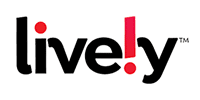How Much Do the Top Medical Alert Systems Cost in 2025?: Researched and Tested by Experts
Our Top Medical Alert Systems
Key Takeaways
- The cost of basic medical alert systems generally starts at around $19.95 per month, or $239.40 per year. In addition, some products have one-time equipment fees ranging from $50–$349.99, and other upfront activation and programming fees can cost up to $100, depending on the product.
- Monthly fees for on-the-go systems are usually higher (about $5–$20 more per month) than fees for at-home systems.
- Many medical alert companies allow you to rent equipment for at-home systems but require you to purchase on-the-go equipment for an additional fee.
- Some features and services (such as 24/7 access to the company’s monitoring center) are included with medical alert systems, while others (such as automatic fall detection) are considered add-ons and come with an additional cost.
- The factors that determine the cost of a medical alert system include: equipment, activation, emergency monitoring, extra devices or pendants, protection plans, add-on features, and lockboxes.
Whether you’re shopping for a medical alert device for yourself or someone you care for, it’s important to compare prices before making a final decision. Medical alert systems generally cost between $20–$45 per month, but there are many other potential fees. To complicate things, prices change depending on the type of system you purchase, and carrying out a medical alert systems cost comparison poses a challenge because no two systems are exactly alike. Plus, different companies use different pricing structures.
For example, the average cost of medical alert systems used in the home differs from that of most on-the-go devices. And while one company may offer a less expensive monthly fee than a competitor’s, they might also charge a hefty upfront equipment fee. To help you sort through the clutter, let’s take a look at everything you need to know about the cost of medical alert systems.
Why you can trust our expert reviews
Our team spent more than 2,500 hours conducting in-depth research on medical alert systems. During our process, we:
- Researched and tested each system independently
- Consulted with licensed professional caregivers and doctors who specialize in caring for older adults
- Mystery shopped 12 medical alert system brands
- Surveyed medical alert system users
- Read hundreds of verified customer reviews from trusted third parties, such as Better Business Bureau (BBB) and TrustPilot
Read more about our medical alert system review methodology.
How much does a medical alert system cost monthly?
Medical alert systems come in two varieties: at-home and on-the-go devices. The brands tested by our team have a monthly fee of $20–$30 for at-home systems. On-the-go systems are generally more expensive. You can expect to pay between $29–$45 for on-the-go monthly fees.
Medical alert systems provide a fast, reliable connection between users and the company’s monitoring center. Centers are staffed 24 hours per day, seven days per week, with trained personnel who can call 911 for you or provide other help over the phone. To learn more about monitoring centers, read how medical alert systems work.
Because these systems provide around-the-clock assistance, medical alert companies charge a monthly fee for the service. This covers the company’s cost of running a fully staffed monitoring center.
How medical alert system prices are determined
Figuring out how much medical alert systems cost is a bit more complicated than other products, like hearing aids, because there are several components that make up your total bill. In addition to a basic monthly fee for the service, some companies charge an activation fee, as well as extra fees for certain equipment and features.
We’ll walk you through a medical alert system’s cost comparison and each part of your monthly cost, so you can feel confident the system will meet your needs and fit your budget.
Installation and activation fees
In general, installation or activation fees are one-time charges that cost between $25–$100. While most of the medical alert systems tested by our team do not charge installation or activation fees, some companies do include these fees in purchase packages—and the fees may not be advertised.
If you’re ordering online, installation or activation fees often appear only at the very end of the transaction when you’re entering your payment information. Before you purchase a system, we recommend calling to ask a customer service representative if they charge activation, installation, or processing fees.
But just because a provider charges one of these fees doesn’t mean it’s an inferior system. In fact, several of the best medical alert systems on the market include an activation or installation fee. Still, it’s important to weigh all of the different cost elements when deciding if the system is a good fit for you and your budget.
Equipment fees
Medical alert companies either rent or sell the equipment for their systems. If you are required to buy the equipment, which is the case for many on-the-go systems, you can pay anywhere from $50–$350, depending on the company and the type of equipment you select. Then the equipment is yours to keep—even if you decide to cancel your subscription.
If you rent your equipment, as is the case with many at-home systems, you will have to return it upon canceling the subscription and pay the shipping costs.
The rental cost is wrapped into the monthly fee, so you will not have an extra up-front equipment fee.
With at-home systems, the type of connection you choose will also affect your monthly monitoring cost. In most cases, you will pay $5–$10 less per month for a landline connection compared to the same company’s cellular connection (a cellular connection uses the same type of network as your smartphone). For example, Bay Alarm Medical charges $24.95 per month for its SOS Home with a landline connection and $29.95 per month for the same package with a cellular connection.
While every medical alert system company differs, keep the following helpful guidelines in mind when pricing equipment:
- Equipment fees are more common with on-the-go systems than at-home systems.
- Specialized equipment with extra features often carry an equipment fee as well. Devices such as smartwatches, smartphones, and at-home systems with activity and temperature sensors fall into this category. It’s a good idea to think about the features you’ll really use in a medical alert system before purchasing. The majority (46%) of respondents to our survey of medical alert users said the biggest challenge with their medical alert system was they “don’t know how to use all the features that it includes.” This may not matter with features that are included at no extra charge, but you can save money by not paying extra for features you won’t use.
- When purchasing equipment, keep an eye out for discounts. Companies frequently offer special pricing, particularly around the holidays.
- Companies that charge up-front equipment fees often have lower monthly fees, while the rental price of equipment can result in a higher monthly fee. It’s important to add up all of the costs before deciding on a medical alert system.
- Many medical alert providers offer risk-free trials of up to 30 days after your purchase date. This is a great opportunity to try out your equipment and determine if it’s a good fit before making a commitment.
Costs of add-on features and services
Nearly every medical alert company offers add-on products (like wall help buttons) and services (like the ability to schedule virtual doctor visits). These add-ons typically come with an extra fee, which may be a one-time charge or an additional monthly fee.
For example, extra wearable help buttons or wall-mounted help buttons are often sold for a one-time cost of $35–$40. Other add-ons cost an additional monthly fee. Most of the brands tested by our team offer automatic fall detection, a popular add-on feature, for an extra $5–$10 per month.
Keep in mind every company has its own pricing system, so you’ll want to look at the website of each medical alert system you’re interested in to examine the fees. If you’re more comfortable looking through brochures, you can go to the company’s website and request a free brochure by mail.
Let’s take a look at the different types of add-ons and fees associated with each medical alert system. By exploring the options and their associated costs, you can decide what features and services are most important to you.
Fall detection
Most providers offer automatic fall detection for at least some of their systems. In our survey, the majority of respondents (60%) told us fall detection is the most important special feature they want in their medical alert system. Falls are very common among older adults (one out of four people aged 65 and older will fall each year, according to the Centers for Disease Control and Prevention1), and fall detection is an excellent safety feature to have in your medical alert system. At just $5–$10 per month, it’s also an affordable one. Use NCOA’s Falls Free CheckUp to gauge your risk of falling and learn more about falls prevention.
Protection plans
Some companies offer a limited warranty that covers normal wear and tear. Purchasing a protection plan provides additional coverage of lost, stolen, or damaged equipment. Of the brands tested by our team, the ones offering additional protection plans charge an extra $1–$7 per month for this option. One exception to this is ADT Health, which provides its premium protection plan at no extra charge.
Wall buttons (for at-home systems)
Some companies charge a one-time fee for wall buttons that typically costs $35–$40. Other companies charge a monthly fee, usually $3–$5 per month. Wall buttons are attached to the walls inside your home and have a large red HELP button that contacts the monitoring center when you push it.
Help buttons (worn on a necklace or wristband)
Like wall buttons, help buttons are priced as either a one-time cost or a monthly fee. Among companies that charge up front, the cost is usually between $25–$35. Companies that charge a monthly fee usually add about $3 per month for help buttons. Help buttons are smaller than wall buttons and are designed to be worn on a necklace or wristband.
Telehealth service
Of the brands tested by our team, only Lively offers telehealth services for an additional fee. Lively offers plans that are $5–$10 more per month than their basic plan. Telehealth services allow you to see a doctor or other medical professional without scheduling an in-person visit. It’s done primarily online, meaning you can see a medical professional from home over your computer or other smart device.
Lockbox
A lockbox is a small, secure box that hangs on an outside door of your home with your extra house key inside. It provides a way for emergency personnel to access your home. Most companies charge about $30 for a lockbox, although some provide them free of charge.
Table 1 Medical alert systems cost comparison, as of 2025
For more details on how much medical alert systems cost, see the table below. Our team covers Life Alert cost in a separate dedicated review.
Company | Required fees Starting monthly fee | Required fees One-time equipment fee | Other fees Installation/ activation | Add-on fees Monthly fall detection fee | Add-on fees Monthly protection plan fee |
|---|---|---|---|---|---|
| Medical Guardian | $29.95 (at home) $39.95 (on the go) | $0 | $0 | $10 | $7 |
| MobileHelp | $24.95 (at home) $34.95 (on the go) | $0 | $100 activation on some devices | $11 | $7 |
| Bay Alarm Medical | $24.95 (at home) $34.95-$39.95 (on the go) | On some products $99–$170 | $0 | $10 | $3 |
| ADT Health | $31.99 | $0 | $0 | $11 | $0 |
| Aloe Care Health | $39.99 | $149.99–$349.99 | $0 | $0 | N/A |
| GetSafe | $29.95 (at home) | $79–$279 | $0 | $10 | $5 |
| HandsFree Health | $34.95 | $179.99-$199.95 | $0 | N/A | N/A |
| LifeFone | $29.95 | $0 | $0 | $5 | $5 |
| LifeStation | $34.95 | $0 | $99.95 activation fee | $5 | $5 |
| Lively | $24.99-$34.99 | $79.99 | $0 activation | $10 | $0 |
| Medical Alert | $19.95 (at home) $39.95 (on the go) | $0 | $50 programming | $10 | $1 |
| Medical Care Alert | $29.95 | $0 | $0 | $10 | $5 |
Best low-cost medical alert systems
Now that you have an idea of the average cost of medical alert systems, let’s look at a few of the best medical alert systems. We found each of these brands offers reasonable pricing and several different systems to choose from.
Medical Guardian
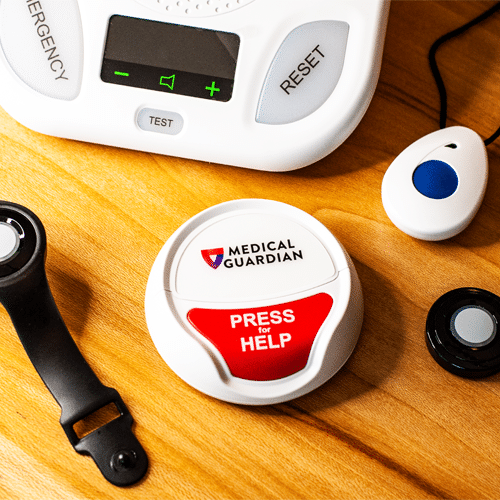
- Activation/installation fees: N/A
- Equipment fees: $150–$200 on some products
- Add-ons: Fall detection ($10/month) and protection plan ($7/month)
Medical Guardian systems start at $29.95 per month for at-home equipment. All three of its on-the-go devices cost $39.95 per month. For caregivers or those looking for automatic alerts when they push the help button, Medical Guardian offers On Guard Alerts for an extra $3 per month. This feature sends notifications to the user’s selected list of contacts (friends, loved ones, caregivers, etc.) any time the help button is pressed.
While Medical Guardian’s prices are at the top of the range for medical alert systems, the company offers five different high-quality devices to choose from. The MGMove smartwatch may appeal to the growing number of customers who prefer a watch over a necklace or bracelet. Indeed, a smartwatch was the most popular type of wearable medical alert system to our survey respondents. At only 1.25 inches in diameter, this smartwatch combines the features of a watch, a medical alert system, and an activity tracker. One downside to the MGMove is it’s the only Medical Guardian device with no option to add fall detection.
If you’re looking for on-the-go devices with optional fall detection, consider the MGMini or MGMini Lite. The MGMini is a compact necklace available in four colors (black, pearl, rose gold, and silver), and the MGMini Lite is the brand’s first wrist-based device with fall detection. We like the MGMini Lite’s sleek smartwatch appearance, similar to an Apple Watch but without the touchscreen or extra features.
Both on-the-go systems have a two-way speaker, GPS tracking, and step tracking.
MobileHelp
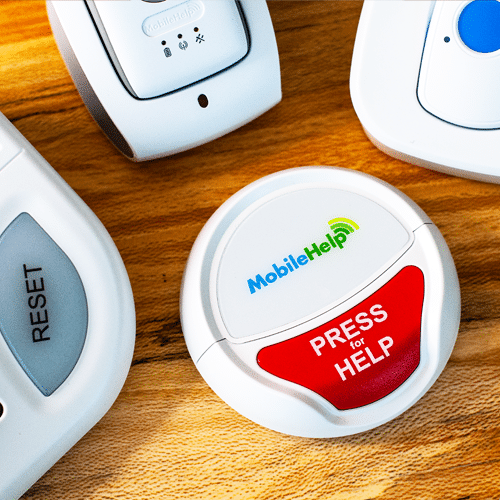
- Activation/installation fees: $100 on some devices
- Equipment fees: N/A
- Add-ons: Fall detection ($11/month) and protection plan ($7/month)
MobileHelp also has low starting monthly fees for its at-home systems, especially for its MobileHelp Classic, a system with a cellular connection. The price starts at $24.95, which is one of the lowest prices available for this type of system.
MobileHelp is also known for its deals on bundled systems. For instance, the Duo, a combination of an at-home base unit and a mobile device with GPS, costs $44.95 per month. The Mobile Duo contains two mobile devices with GPS and costs $49.95 per month. Perfect for a multi-person household, it’s a combination carried by few other companies. These bundled system prices beat the cost that some providers charge for a single on-the-go system. And they do not require equipment fees.
Bay Alarm Medical
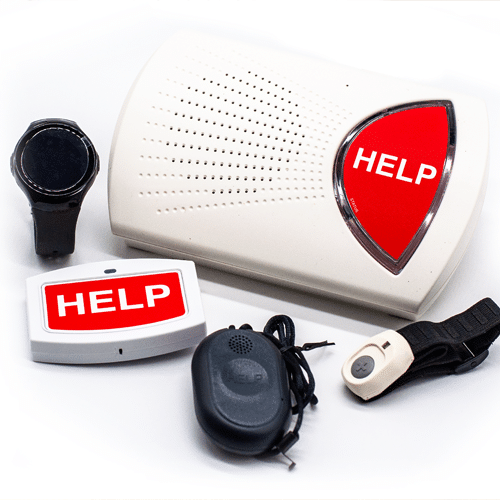
- Activation/installation fees: N/A
- Equipment fees: $99–$170 on some products
- Add-ons: Fall detection ($10/month) and protection plan ($3/month)
Bay Alarm Medical offers some of the best all-around prices on monthly fees. The starting fee for the Bay Alarm at-home system is $24.95 per month (with a landline connection). The three on-the-go systems are SOS Mobile ($34.95 per month), the SOS All-in-One ($39.95 per month), and the SOS Smartwatch ($34.95 per month.) This is a reasonable price compared to the other brands tested by our team, which ranged from $20–$44 per month.
Bay Alarm Medical does require customers to buy its on-the-go equipment, but the $99–$170 equipment fee is only a one-time payment and will give you a lower monthly price moving forward. This could be a good option for a friend or family member who wants to buy the equipment as a gift, allowing for a lower monthly price for the user.
GetSafe

- Activation/installation fees: N/A
- Equipment fees: $79–$229 on some devices
- Add-ons: Fall detection ($10/month) and protection plan ($5/month)
Because GetSafe is primarily focused on at-home systems that operate without necklaces or wristbands, it’s easy to overlook a bargain on the mobile device, which the company lists as an add-on rather than a separate system.
The Mobile GPS Help Button costs $79 upfront for the equipment fee, but the monthly monitoring fee is only $20. Of the brands we tested, only Lively offers an on-the-go system at that price. GetSafe is a good option for customers who want a quality on-the-go medical alert system at a reasonable price.
For more information about GetSafe, read our GetSafe review.
Lively
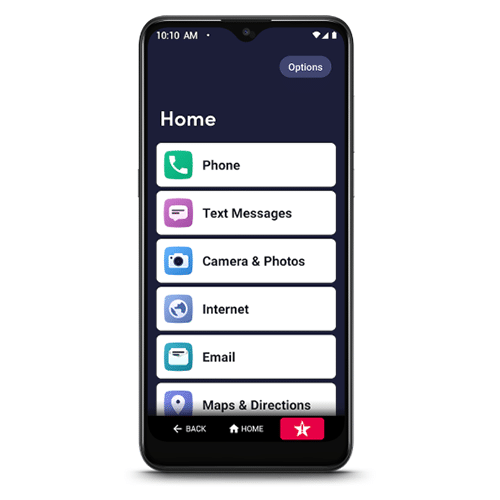
- Activation/installation fees: $25–$35
- Equipment fees: $50–$80
- Add-ons: Fall detection ($10/month)
Lively is a unique provider of medical alert systems. The company offers cell phones that double as medical alert systems, as well as more traditional on-the-go medical alert devices.
Lively’s pricing on its phones is competitive compared to many other cell phones on the market. For example, the Jitterbug Smart3 is a smartphone made by Samsung and costs $150, which beats the price of most smartphones by several hundred dollars.
In addition to the purchase price of the phone, which takes the place of the equipment fee for other types of medical alert systems, you will need to choose a talk and text package in order to use it.
The company’s basic talk and text package is $15 per month, and its unlimited package (with no limit on how many texts you send or minutes you talk on the phone) is $20 per month. Its Jitterbug Smart3 also offers five different data packages depending on how much you use the internet on your phone. Data packages range in price from $2.50 to $30 per month.
You can stop there if you just want to use your Lively phone as you would any other cell phone. If you want to use it as a medical alert device, you’ll need to pay an additional $20–$35 per month to add medical alert monitoring. Compared to cell phones, Lively’s other mobile devices come with slightly higher monthly fees of $25–$40 per month.
With both the mobile devices and the cell phones, the more expensive monthly monitoring packages include telehealth services and an app that alerts your chosen list of friends, family, and caregivers if you contact the Lively monitoring center.
For more information about Lively, read our Lively medical alert review.
Medical Alert
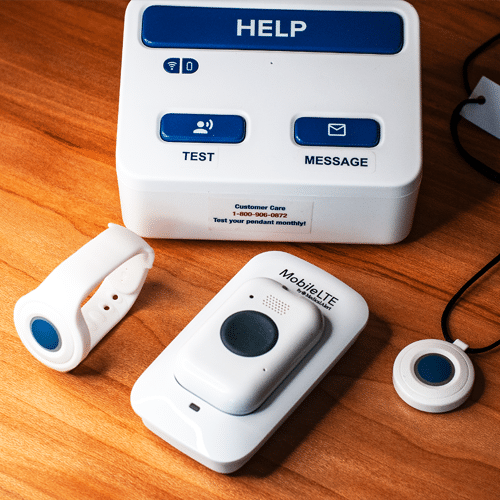
- Activation/installation fees: $50 (on-the-go system)
- Equipment fees: N/A
- Add-ons: Fall detection ($10/month) and protection plan ($1/month)
Medical Alert offers a powerful smartphone app with several useful features, including location tracking, alerts for approved contacts when the user presses the help button, and a way to connect with customer support. These are all valuable functions, but location tracking is an especially popular feature. In fact, “location tracking” was the second most popular special feature in a medical alert system according to our survey respondents—behind only “automatic fall detection.” Location tracking uses GPS (global positioning system) technology, which relies on satellites to pinpoint the user’s exact location. The location data is encrypted (meaning it’s converted into a code so any hackers or other criminals cannot read it), so your exact location is safeguarded and only accessible by Medical Alert.
Compared to other medical alert systems on this list, Medical Alert has one of the lowest starting monthly fees at $20 for its at-home system. But be aware that it’s one of the only companies on this list that charges an activation/installation fee ($50).
Some companies offer access to a mobile app with their basic monthly fees (others may only give you access if you choose a more expensive plan or device). Medical Alert is a great example. Both its at-home and on-the-go systems include an app with all of the useful features listed above. This can be especially valuable for friends and family of someone who has a medical condition or lives alone.
Also, be sure to check out our comparison is Medical Alert vs. Medical Guardian if you’re torn between these two brands.
Tips for saving money on medical alert systems
Although they can be expensive, there are many ways to save money on medical alert systems. Take a look at the tips below and see which ones can help you stretch your dollars.
Bundle your medical alert devices
Bundling refers to purchasing two devices at a discounted rate. Most companies offer at least one bundled system, often packaged as an at-home system plus an on-the-go system.
For example, Bay Alarm Medical offers a bundled SOS Home (cellular) plus the SOS Mobile for $60.95 per month. If sold separately, the SOS Mobile costs $32.95 per month and the SOS Home with cellular costs $32.95. If you buy them as a bundled system, you can save $4.95 per month, or $59.40 per year.
A few companies also offer two on-the-go devices as a bundled system. For instance, MobileHelp sells the Mobile Duo (two Mobile Solo devices) for $49.95 per month. If the Mobile Solos were sold as separate items, the cost would be $34.95 per month each. This is a savings of about $20 per month, almost a two-for-one deal.
Of course, no discount is a good deal unless it’s useful for your situation. Not everyone needs two systems. We recommend a bundled system for households with more than one person.
Choose an alternative to the monthly payment plan
Most providers offer several types of subscriptions. Rather than choosing the monthly payment option, you can choose to pay quarterly, semiannually, or annually. The more months you pay for at one time, the more money you save.
Many companies will give you a lower monthly rate if you choose a quarterly or yearly payment plan. With the LifeFone VIPx®, for example, you’ll pay $44 per month for a monthly plan, $42 per month for a quarterly plan, and $40 per month for an annual plan.
You may be able to save even more money by taking advantage of the freebies some companies offer if you select their annual payment plan. For example, Medical Guardian offers a free month of service, free lockbox, and free shipping if you pay the annual $439.45 fee upfront for the MGMini.
For a detailed medical alert systems cost comparison and a breakdown on how much you can save by opting for an annual subscription fee rather than monthly, see Table 2 below.
Table 2 Medical alert system subscription fees, as of 2025
Provider | Monthly fee | Annual subscription fee | Total savings |
|---|---|---|---|
| Medical Guardian | $30–$45 | $330–$500 | $24–$36 annually |
| MobileHelp | $25-$50 | $275–$550 | $25–$50 annually |
| Bay Alarm Medical | $25–$40 | $299–$479 | $25–$41 annually |
| Medical Alert | $20–$30 | $181–$321 | $20–$35 annually |
| LifeFone | $30–$48 | $299–$527 | $48–$60 annually |
| HandsFree Health | $45–$50 | N/A | N/A |
| Lively | $20–$50 | N/A | N/A |
| ADT Health | $30–$40 | $312–$432 | $48 annually |
| LifeStation | $23–$44 | $239 | $37 annually |
| Medical Care Alert | $30 | $327 | $180 annually |
| Aloe Care Health | $30–$50 | N/A | N/A |
| GetSafe | $29 | N/A | N/A |
Only buy the features you will use
Medical alert companies offer two pricing structures: tiered pricing and à la carte pricing. Most providers use à la carte pricing, charging a starting monthly fee and allowing you to choose from a menu of add-on products and services.
With tiered pricing, you can select from a few different packages. One is often a basic package with no extras included. Companies usually also offer a mid-level and premium package, which include more extras.
It’s important to think about the features and services you really need before purchasing a package. This way you won’t be paying more for unnecessary features. If you’re not sure how to choose, talk to a trusted friend or family member to see what they think would be most helpful for you.
Call customer service to ask for discounts
Holidays are a great time to look for discounted medical alert systems. This may come in the form of a lower rate on the equipment, the monthly fee, or the accessories.
We see sales around Memorial Day, the Fourth of July, Thanksgiving, Christmas, and other holidays. Keep your eye on the website of any brand you’re interested in, but also call customer service and ask if they will be running any sales in the coming days or weeks. If they know you’re interested in buying, they may give you a discount.
Use veterans benefits to help pay for your system
If you’re a U.S. veteran, you have access to several discounts on medical alert systems. First, check with your local Veterans Affairs (VA) office for benefits that cover medical alerts.2 The VA partners with several medical alert companies, and you might be eligible for a system that’s partially or fully paid for by the VA.
In addition, several medical alert providers offer special benefits for veterans. This includes Aloe Care Health, which offers a free month of service for veterans. MobileHelp offers a “Dollar Discount” on any of its systems, which gives you $60 off. The company also offers Connect Premium, the MobileHelp $7-per-month protection plan, free of charge for veterans.
Finally, if you are a member of the American Legion or Veterans of Foreign Wars, you may be eligible for a member discount with LifeStation medical alert systems.
Check into membership benefits
AARP and Costco are two memberships that could be helpful when purchasing a medical alert system.
Currently the AARP membership and benefits page features two medical alert companies that offer discounts.
- Lively offers an annual $60 savings on the Preferred and Ultimate health and safety packages when you buy the Lively Mobile Plus or Lively Wearable2 device.
- Philips Lifeline offers a 15% discount on the monthly fee in addition to free shipping and activation.
Learn more about AARP and medical alert systems in our guide.
You can purchase Medical Guardian products both online at the company’s website and in-person at Costco. With a Costco membership, you can take advantage of two discounts from Medical Guardian.
- The Mini Guardian, which normally includes a $125 equipment fee, is available to Costco members for $100.
- The MGMini, which normally includes a $199.95 equipment fee, is available to Costco members for $129.99.
Identify insurance benefits
Unfortunately, Original Medicare (Parts A and B) does not cover the cost of medical alert systems.3 Although Part B covers durable medical equipment, medical alert systems do not fall into this category.
Medicare Advantage (Part C) is offered by private companies that are Medicare-approved and follow the rules set up by Medicare. Medicare Advantage plans vary state by state, and they might offer some coverage for medical alerts depending on the state in which you live and the details of the plan. Call your plan provider to see if they will help cover your medical alert device.
People who may want a medical alert system but are not enrolled in Original Medicare or Medicare Advantage include those who:
- Are working past the Medicare-qualifying age of 65 and continue to use their employee group health plan
- Are 65 or older and use a working partner’s employee group health plan
- Are younger than 65 but have a medical condition requiring the use of a medical alert device
Most private insurance or Affordable Care Act plans do not include coverage for medical alert systems.4 But it’s still a good idea to call your plan provider for exact details.
Finally, long-term care insurance may provide some coverage for medical alert systems. Like Medicare Advantage, the plans vary in each state. Contact your plan provider to see if they provide coverage for medical alert systems.
For more help understanding your Medicare benefits, use the in-depth Medicare guidance in NCOA’s Age Well Planner.
Refer a friend
Several medical alert companies offer referral programs. If you refer a friend to the company you bought your medical alert device from and they become a customer, you can get a freebie such as a free month of service. Your friend may also receive some type of benefit. A few systems offering this discount include Lifefone, MobileHelp, and Lively.
Other deals
We found a few other money-saving deals worth taking a look at.
- ADT Health: You may recognize ADT as a provider of home security. If you already own an ADT home security system or wish to purchase one, the company will provide a discount on your ADT medical alert system.
- Medical Care Alert: Most companies offer a limited warranty on normal wear and tear and a protection plan (for an additional monthly fee) for lost, damaged, or stolen equipment. Medical Care Alert offers a full 100% warranty free of charge.
How to choose the best medical alert system for you
Before shopping, think about the following questions. Asking yourself these questions can help you find a medical alert system that is a good fit and has only the features and services you truly need. Taking a few minutes to do this can help keep your overall costs as low as possible.
- Do you live alone? If so, you may want to consider a medical alert system that functions both at-home and on-the-go.
- Do you travel by yourself, either around town or farther away? It may be a smart idea to use an on-the-go system with GPS location detection.
- How important is style to you? If it’s a priority, you may be interested in spending a bit more on a smartwatch or necklace-style device.
- Do you have a chronic health condition or have you fallen at least once before? If your answer is yes, think about getting a device with fall detection.
- Do you or your care recipient have trouble with memory or keeping track of things? If so, a protection plan to pay for lost devices could end up saving you money.
- Does your care recipient have a cognitive impairment that causes them to wander away from home? If so, you may want an on-the-go device with GPS tracking to help pinpoint their location in the event they’ve wandered off.
- Do you have a spouse, partner, or other older adult living in the same household? In this case, a bundled package with multiple wearable devices can be a smart way to save money on your medical alert system.
- Do you dislike charging your devices every day, or have trouble remembering to do it? Spending a little extra money for a system with an above-average battery life may be worth it.
- Do you want a help button that can be worn in the shower? If the answer is yes, you’ll want a waterproof help button. If not, you may want to consider one or more wall-mounted help buttons for the hallway or bathroom so you can reach it at all times.
The bottom line
Medical alert systems costs can be an obstacle for many people. If you’re an older adult on a fixed income, it’s understandable to be concerned about paying a monthly fee for a system.
Some people may feel that because they have a cell phone, they don’t need to also spend their money on a medical alert device. But medical alert systems can provide potentially lifesaving benefits that smartphones don’t.
“I believe strongly in medical alert systems as they are built for one purpose: getting help if there is an emergency,” said Jonathan Marsh, owner and administrator of Home Helpers of Bradenton, a home care agency. “They are very simple to use, proven, continuously improved over many years, and do not require the tech-savviness associated with using smartphones.”
You can choose from a wide variety of systems and prices, and there are also many ways to cut costs and find discounts.
If you live on a fixed income and are looking for other ways to save on daily expenses like health care and food, visit NCOA’s BenefitsCheckUp®. You can take a free online screening to see what money-saving benefits programs you might be eligible for.
Frequently asked questions
At-home systems typically charge a monthly fee between $20–$30. Only a few specialized systems require an equipment fee. With on-the-go systems, most systems cost between $30–$45 per month. Equipment fees vary with on-the-go systems.
A medical alert system provides a layer of protection to older adults (especially those living alone) and individuals of all ages living with medical conditions. Because medical alert systems provide access to immediate help during a medical emergency, they also provide confidence to those living alone or traveling by themselves. And they provide peace of mind for friends and loved ones. For these reasons and more, medical alert systems are worth the money for people who need them.
We found that Bay Alarm Medical offers high-quality equipment with a lower-than-average price tag. Its at-home systems start at $24.95 per month, and on-the-go systems start at $29.95 per month. Keep in mind the company does charge an equipment fee for some of its devices.
If you are looking for an at-home system, MobileHelp, Medical Alert, and Life Station also provide solid systems for low monthly fees that do not include equipment charges.
If you are looking for an on-the-go system with reasonable pricing, MobileHelp and Lively are good options.
Have questions about this review? Email us at reviewsteam@ncoa.org.
Sources
- Centers for Disease Control and Prevention. Facts About Falls. May 12, 2023. Found on the internet at https://www.cdc.gov/falls/about/index.html
- U.S. Department of Veterans Affairs. Find VA Locations. Found on the internet at https://www.va.gov/find-locations
- Medicare.gov. Parts of Medicare. Found on the internet at https://www.medicare.gov/basics/get-started-with-medicare/medicare-basics/parts-of-medicare
- HealthCare.gov. Affordable Care Act (ACA). Found on the internet at https://www.healthcare.gov/glossary/affordable-care-act









